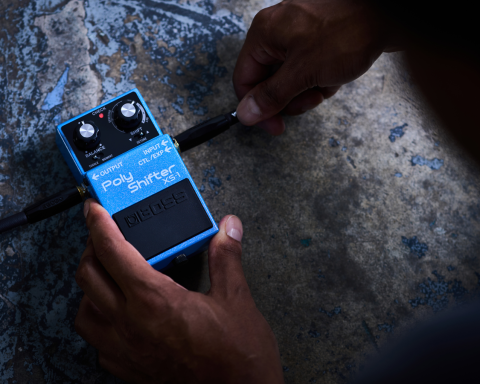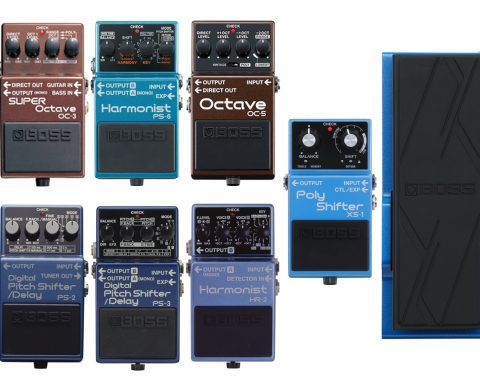The BOSS MO-2 Multi Overtone pedal is a comprehensive creative tool, combining several different effects with a versatile range of applications, simple controls, and on-the-fly functionality. The MO-2 is part of the BOSS Multi-Dimensional Processing (MDP) effects range. A detailed processing system, MDP can analyze and apply a varying effect based on frequencies and playing dynamics. The result is complex, unique, and interesting, combining characteristics from several effect types. Learn to harness this extraordinary pedal.
What is Multi Overtone?
The MO-2 is a pitch-shifting effect that can uniquely focus on either high or low frequencies or both simultaneously. At the same time, it adds a range of modulation effect characteristics and creates complex harmonies to thicken and excite even the simplest of guitar parts.
How to Use the MO-2
The BOSS MO-2 features four controls that can manipulate a range of tones. Balance is a blend control, blending more of the affected signal alongside the clean signal. This allows players to use the MO-2 for everything from a subtle hint of modulated octaving to a completely wet synth-organ-like tone
What is Multi Overtone?
The MO-2 is a pitch-shifting effect that can uniquely focus on either high or low frequencies or both simultaneously. At the same time, it adds a range of modulation effect characteristics and creates complex harmonies to thicken and excite even the simplest of guitar parts.
How to Use the MO-2
The BOSS MO-2 features four controls that can manipulate a range of tones. Balance is a blend control, blending more of the affected signal alongside the clean signal. This allows players to use the MO-2 for everything from a subtle hint of modulated octaving to a completely wet synth-organ-like tone
"As the detune control gets turned clockwise, it can create anything from a gentle doubling effect to a rich chorus effect or a space-age vibrato."
The final rotary control on the MO-2 is the Mode selector. This control switches between three distinct voicings for the pedal. In Mode 1, the balance control blends in a single +1 octave, and the detune control creates a mild thickening to the voicing. In Mode 2, the balance control combines a +1 octave and -1 octave, and the detune control creates a wide, modulated Leslie-type effect. In Mode 3, the balance control blends in a single -1 octave with some upper harmonic characteristics. The detune control adds a distinct chorus/vibrato-like tone to the effect.

Setup Considerations
Positioning the MO-2 in an effects chain is less evident than with most effects. Essentially, the pedal deals with both pitch shifting and modulation. These effects usually operate best in different places on a pedalboard. However, due to the pedal’s versatility, it can work in various spots.
All pitch-shifting effects work best when they receive a clean, dynamic signal. The MO-2 is an MDP-based effect that excels at interpreting playing dynamics to create detailed, three-dimensional effects. Positioning the pedal at the beginning of an effects chain is a great way to maximize its capabilities. However, the MO-2 works well with overdrives on either side to create exciting effects. It also works well placed after a delay pedal to add shimmery tones.
Maximizing a Multi Overtone Pedal
12-String Emulator
The MO-2 emulates the harmonics and rich tonal characteristics of a 12-string guitar. Distinctive and unique, a 12-string is an ideal instrument for rich, jangly chords and immersive psychedelic sounds.
To create this effect with the MO-2, select Mode 1 from the mode control. This setting adds a harsh, biting upper octave to the guitar signal. Blend the upper octave so that it’s roughly balanced alongside the guitar’s natural tone. Next, roll the tone control to around 10-11 o’clock. This will soften some of the harsher frequencies of the upper octave, making them more natural and in step with the tone of the clean guitar signal. Finally, roll the detune control back to around 9 o’clock. While the modulation is gentle in Mode 1, emulating a 12-string requires a clean and natural tone. Using the detune at a low setting will achieve that.
"The MO-2 emulates the harmonics and rich tonal characteristics of a 12-string guitar."
Synth Choir (Volume Swells)
The MO-2 can be an excellent tool for creating huge wall-of-sound synth tones in a more extreme setting. Perfect with a mid-speed digital delay and a touch of reverb for a Vangelis-style synth swell.
To achieve this, set the MO-2 to Mode 3. Mode 3 engages a single, high-quality sub-octave. Blend this to around 2 o’clock for a thick, full-bodied bass synth-style tone. Next, set the detune control to a little past 12 o’clock for a lush, warbly vibrato-style modulation. The trick with this setting is to use the guitar’s volume control to swell in slowly strummed chords. This technique creates massive, menacing, sub-synth tones with sparkling harmonics and tasteful modulation.
"The MO-2 can be an excellent tool for creating huge wall-of-sound synth tones in a more extreme setting."
Unique Basslines
The M0-2 keeps things from sounding glitchy or synthetic when the balance control gets rotated fully clockwise. The MDP technology allows the notes to track well and replicates playing dynamics. This is useful for creating tones like a bass guitar or synth. Here’s how to achieve this perfect setting for simple basslines and creating texture.
- Select Mode 3 and set the balance fully clockwise for a sub-octave focussed tone.
- Roll the tone control back to around 9 o’clock, taming some harsher upper harmonic frequencies and creating a thick, fat bass tone.
- Dial the detune control back to around 10 o’clock for a subtle but present vibrato-like thickening to the tone.
Airy Chorus
The modulation element of the MO-2 is a feature to pay attention to. Engage it to create rich, lush chorus-style effects while using the shimmering pitch-based side of the MO-2 for added texture. The result is a classic chorus tone with a hint of shimmering octaves and subby presence. The vibe is perfect for guitarists looking for something different from their modulation tones.
- Select Mode 2 and set the balance control at 8-9 o’clock. This will keep the clean guitar signal clear and present and the dual octaves subtle and textural.
- Set the tone control to around 1 o’clock for a shimmering treble-heavy global tone.
- Blend in the detune control to a point where the pulse of its LFO is relatively fast, but the clean, tuned notes are still audible and focused.
"A Multi Overtone pedal is a distinctive effect that can expand a guitarist’s pitch-shifting capabilities and modulation options."
Expanding Options
A Multi Overtone pedal is a distinctive effect that can expand a guitarist’s pitch-shifting capabilities and modulation options. It can emulate an array of instruments, from 12-string guitars to bass synthesizers. Plus, its versatility makes it well-suited to applications in countless genres.






